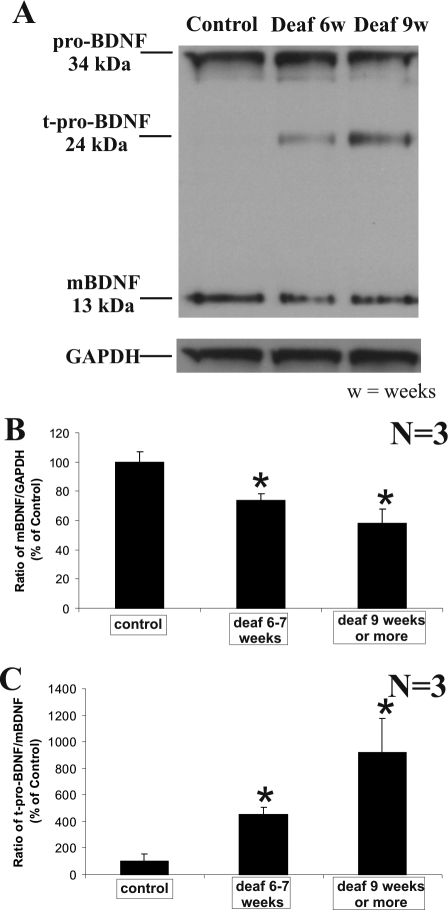Figure 7-6921.
BDNF protein is differentially processed in aminoglycoside-deafened cochleae. A: Western blot analysis of the cochleae from normal hearing animals and animals experiencing two distinct durations of deafness (shown here for 6 and 9 weeks) demonstrated a reduction in the mature form of BDNF (mBDNF) and the appearance of a truncated form of pro-BDNF (t-pro-BDNF) after 6 and 9 weeks of deafness. The intensity of the truncated pro-BDNF fragment increased from 6 to 9 weeks of deafness. In contrast, the expression of the unprocessed form of BDNF (proBDNF) showed relatively little fluctuation, in comparison with both the mature BDNF and truncated pro-BDNF species. As loading controls, the level of the housekeeping protein, glyceldehyde-3-phosphate dehydrogenase, remained constant in these samples (A, GAPDH). By quantifying the intensity of these bands, we normalized the intensity of the mature BDNF band to the GAPDH in three independent experiments and the mean ratio for each group was then expressed as a relative percentage of the control group of normal hearing animals (B). We observed a significant reduction in the ratio of mature BDNF to GAPDH in a cohort experiencing 6 to 7 weeks deafness (B, *P < 0.05), as well as another cohort with a deafness duration exceeding 9 weeks (B, *P < 0.05). C: To demonstrate the relative levels of truncated pro-BDNF versus mature BDNF in each group, we divided the intensity of truncated pro-BDNF band by that of mature BDNF band and expressed the mean ratio for each group as a relative percentage of the control group of normal hearing animals. Comparison between the control group and each of the deafened cohorts showed a significant increase in this ratio in animals deafened for 6 to 7 weeks (*P < 0.05) and animals experiencing more than 9 weeks of deafness (*P < 0.05). Numerical data indicate means ± SEM.

